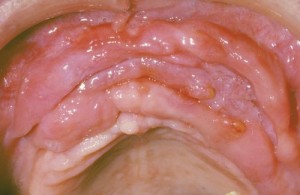Oral pemphigoid (pemphigoid of the mouth) is an uncommon blistering condition which affects primarily the lining of the mouth and gums. Other moist surfaces of the body (known as mucous membranes) can also be affected, and these include the surface layers of the eyes, inside the nose and the genitalia. The skin is less commonly involved but can be affected by a similar blistering condition, known as bullous pemphigoid. Continue reading
Tag Archives: ulcer
RADIATION THERAPY AND DENTISTRY PART I
Using of ionizing radiation to kill cancer cells.
How does radiotherapy work?
Radiation therapy kills cells by interacting with the water molecules which are present in our cell. Charged molecules will be produced and distrupt the biochemical process of our cells. (DNA is damaged) Continue reading
Biopsy: What to Expect
Sometimes you may hear the term ‘biopsy’ when investigations are required for certain lesions in the mouth. Biopsy sounds like a scary procedure that brings the word ‘cancer’ to mind but in fact it is just an aid for diagnostic purposes. Continue reading
Causes of ulcers in the mouth
What are the causes of ulcers in the mouth?
1. Trauma
i) Mechanical trauma
Accidentally biting your lips or cheeks or brushing your teeth too vigorously to the point of accidentally hitting your gums with the head of your toothbrush can lead to oral ulcers; some people are prone to biting himself because of the presence of a sharp tooth in the mouth. Continue reading
How Vitamin B12 deficiency causes Canker Sore
What are canker sores?

Canker sore
Canker sore also known scientifically as aphthous ulcer, is a common type of ulcer found in the mouth, gums, sometimes the upper throat region. It usually involves the breaking down of mucosal surface, which is the inner lining of the mouth, and this exposes the underlying tissue, leading to immense pain especially with contact or movement.
What are the oral signs and symptoms of canker sores
Depending on the size of the ulcers, they can be categorized under minor or major aphthous ulcers. Minor ulcers are anything less than 1cm in diameter while major ulcers extend beyond 1cm in diameter and can be extremely painful. They both usually have a yellow or whitish base where the tissue is exposed and a fiery red border is found around the ulcer. Minor ulcers usually only takes a few days up to a week to heal and major ulcers take much longer, sometimes up to two weeks. Minor ulcers can coalesce to form one big ulcer in which healing will again be delayed. Multiple small ulcers found in a cluster are usually herpetic form of ulcerations with a viral origin. Continue reading
Denture-related problems affecting the mouth Part2
continuation of part 1
4)Â Â Â Â Â Epulis fissuratum (denture fibrous hyperplasia)
Commonly seen in those with poor fitting denture for a long period of time, the lesion may be due to the sharp denture margins or overextended flanges leading to chronic irritation of the soft tissues. It can appear as a single or multiple fold of tissue that grown in excess around the mucobuccal groove, which is the area where the gums meet the inner cheek. The tissue‘s mobility and continued growth can cause problems in maintaining denture retention. Painful ulceration is common in the base of the fold.
Treatment: Surgical excision of lesion and new denture construction. Continue reading
Denture-related problems affecting the mouth Part1
Dentures are intended to restore function of your mouth but sometimes they can be responsible for many common lesions found in the mouth. The lesions tend to occur in greater frequency in removable dentures (complete or partial dentures) compared to permanent dentures (bridge or implants) as removable dentures can be distorted or broken with use. Furthermore, the older age group is more commonly affected as they often do not comply with instructions for proper removal, placement, maintenance and cleaning dentures.



